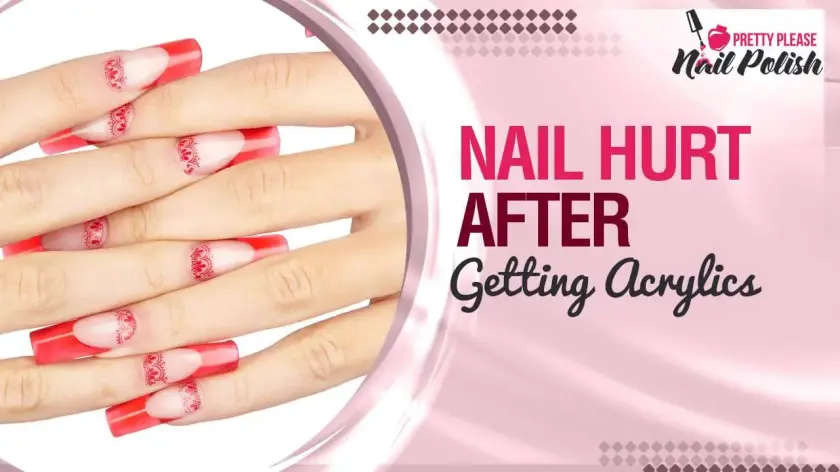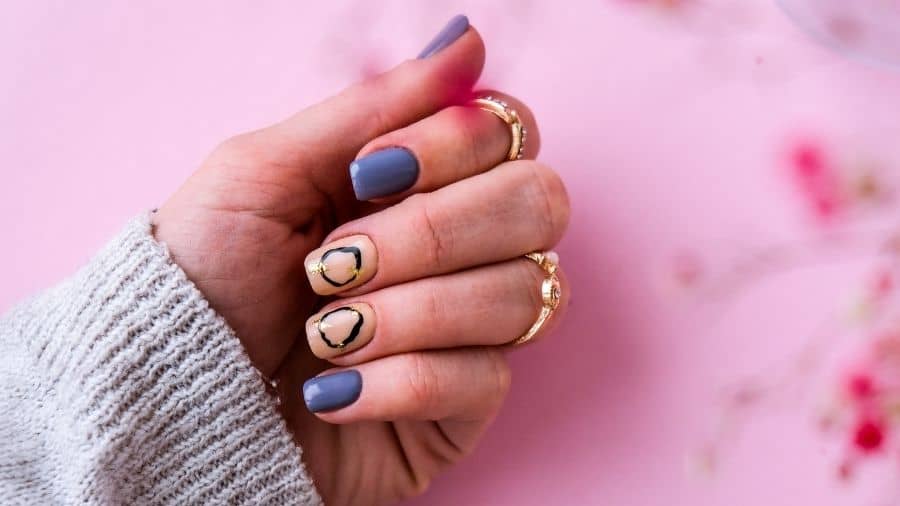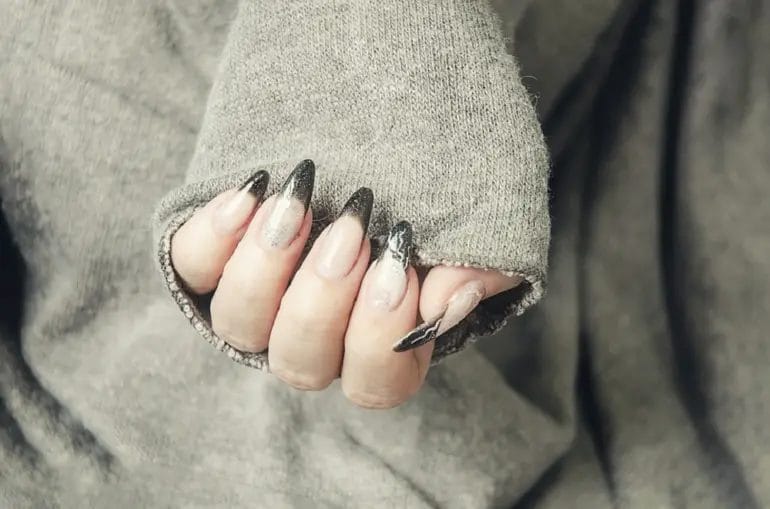If you’re experiencing soreness in your fingers after getting acrylics, you’re not alone. The application process involves filing and buffing of the natural nail, which can cause temporary discomfort. Additionally, the weight of the acrylics may put pressure on your fingers, resulting in soreness. It’s important to note that this discomfort is usually temporary and should subside within a few days. However, if the pain persists or worsens, it’s advisable to consult with a professional nail technician or healthcare provider.

Common Factors Leading to Finger Soreness After Acrylics
Acrylic nails have become a popular choice for those who want to have stunning and long-lasting manicures. However, along with their aesthetic benefits, acrylic nails can sometimes cause discomfort and soreness in the fingers. In this section, we will explore the common factors that can lead to finger soreness after getting acrylic nails.
Tightly Applied Nails
One of the primary reasons for finger soreness after acrylic nails is having them applied too tightly. When the acrylic nails are applied too tightly, they can put pressure on your natural nails and surrounding skin. This pressure can lead to discomfort and soreness. It is essential to ensure that the nails are not applied too tightly during the application process.
Improper Nail Preparation
Another factor that can contribute to finger soreness after acrylic nails is improper nail preparation. Before applying acrylic nails, it is crucial to properly clean, shape, and buff the natural nails. If the nails are not adequately prepared, the acrylic application can be uneven, leading to pressure points and discomfort.
Incorrect Nail Length
The length of the acrylic nails can also play a role in finger soreness. If the nails are too long or too short, they can put strain on the fingertips and nail beds, causing discomfort. It is essential to find a balance between aesthetics and comfort when choosing the length of acrylic nails.
Low-Quality Acrylic Products
The quality of the acrylic products used can significantly impact the comfort and durability of acrylic nails. Low-quality acrylic products can be harsh on the nails and skin, leading to soreness and irritation. It is advisable to choose high-quality acrylic products to ensure a more comfortable experience.
Improper Removal Techniques
Improper removal of acrylic nails can also cause finger soreness. It is essential to follow the correct removal techniques to prevent damage to the natural nails. Trying to forcefully remove the acrylics or picking at them can lead to nail bed damage and subsequent soreness.
Allergic Reactions
In rare cases, finger soreness after acrylic nails can be caused by an allergic reaction to the products used. Some individuals may develop an allergic reaction to certain ingredients in acrylic products, leading to discomfort and soreness. If you suspect an allergic reaction, it is crucial to seek professional help and discontinue the use of acrylic nails.
In summary, finger soreness after getting acrylic nails can be attributed to various factors, including tightly applied nails, improper nail preparation, incorrect nail length, low-quality acrylic products, improper removal techniques, and allergic reactions. By addressing these factors and taking proper care of your nails, you can minimize the chances of experiencing finger soreness after acrylics.

Tips to Alleviate Soreness and Discomfort from Acrylic Nails
Acrylic nails are a popular choice for those who want to enhance the appearance of their natural nails. However, sometimes wearing acrylic nails can lead to soreness and discomfort. If you’re experiencing any discomfort or pain from your acrylic nails, there are several tips you can follow to alleviate these symptoms. In this section, we will explore some effective ways to relieve soreness and discomfort caused by acrylic nails.
1. Soak your nails
One of the first steps you can take to alleviate soreness and discomfort is to soak your nails in warm water. Fill a bowl with warm water and add a few drops of gentle liquid soap or baby oil. Soak your nails in this solution for about 10-15 minutes. This will help to soften the acrylic and relieve any discomfort you may be experiencing.
2. Apply cuticle oil
After soaking your nails, it’s important to moisturize them to prevent further dryness and discomfort. Apply cuticle oil or any nourishing oil such as almond or jojoba oil to your nails and cuticles. Massage the oil gently to promote blood circulation and hydrate the skin. This will help to reduce soreness and keep your nails healthy.
3. Use a nail buffer
If you’re experiencing discomfort due to rough or uneven acrylic nails, using a nail buffer can help. Gently buff the surface of your nails to smooth out any rough areas or sharp edges. Be careful not to over-buff, as this can damage the acrylic. Buffing will help to reduce soreness and make your nails more comfortable to wear.
4. Avoid excessive pressure
Another tip to alleviate soreness is to avoid putting excessive pressure on your nails. Be mindful of activities that may strain or bend your nails, such as opening cans or using your nails as tools. By taking these precautions, you can prevent any additional discomfort and allow your nails to heal properly.
5. Give your nails a break
If you’re experiencing persistent soreness or discomfort from your acrylic nails, it may be beneficial to give your nails a break. This means removing the acrylic nails and allowing your natural nails to breathe and recover. This break will not only relieve any discomfort but also promote the health and strength of your natural nails.
6. Consult a professional
If your soreness and discomfort persist or worsen, it’s important to consult a professional nail technician or a dermatologist. They can assess your nails and provide appropriate advice or treatment. It’s always better to seek professional help if you’re unsure or concerned about any issues with your acrylic nails.
In summary, if you’re experiencing soreness and discomfort from your acrylic nails, there are several steps you can take to alleviate these symptoms. Soaking your nails, applying cuticle oil, using a nail buffer, avoiding excessive pressure, giving your nails a break, and consulting a professional are all effective ways to relieve soreness and discomfort. By following these tips, you can ensure a comfortable and enjoyable experience with your acrylic nails.

Preventive Measures to Minimize Finger Soreness with Acrylics
Acrylic nails have become a popular trend in the world of nail art. They offer durability and a wide range of design options, making them a favorite choice for many individuals. However, frequent use of acrylic nails can sometimes lead to finger soreness and discomfort. If you frequently experience finger soreness when wearing acrylic nails, here are some preventive measures you can take to minimize the discomfort.
1. Proper Nail Preparation
One of the main causes of finger soreness with acrylics is improper nail preparation. Before applying acrylics, it is important to ensure that your natural nails are clean and properly filed. This will help the acrylic adhere better and reduce the pressure on your nails, minimizing the risk of soreness.
2. Use High-Quality Acrylic Products
Using high-quality acrylic products can make a significant difference in preventing finger soreness. Opt for professional-grade acrylic powders, liquids, and primers that are specifically formulated for nail enhancements. These products are designed to be gentler on your nails and minimize any potential irritation or discomfort.
3. Avoid Unnecessary Pressure
When wearing acrylic nails, try to avoid activities that put excessive pressure on your nails and fingers. This includes activities such as typing aggressively, opening cans or bottles with your nails, or using your nails as tools. Applying unnecessary pressure can strain your nails and lead to finger soreness.
4. Regular Maintenance
Regular maintenance is essential to prevent finger soreness with acrylic nails. Visit a professional nail technician for regular fill-ins every two to three weeks. During these appointments, the technician can check for any signs of lifting or damage and make the necessary repairs. This will help maintain the structural integrity of your nails and prevent any discomfort.
5. Moisturize Your Nails and Cuticles
Proper hydration is crucial for healthy nails and cuticles. Moisturize your nails and cuticles regularly using a nourishing cuticle oil or cream. This will help prevent dryness and minimize the risk of cracking or peeling, which can contribute to finger soreness.
6. Take Breaks
Giving your nails a break from acrylics can help alleviate any finger soreness you may be experiencing. Consider going without acrylics for a period of time to allow your natural nails to recover. This will give your nails a chance to breathe and regenerate, reducing the risk of soreness.
7. Pay Attention to Nail Length
Keeping your acrylic nails at a reasonable length can help prevent finger soreness. Extremely long nails can put additional strain on your fingers and increase the likelihood of discomfort. Opt for a length that is comfortable for you and try to avoid excessively long extensions.
8. Seek Professional Help
If you continue to experience persistent finger soreness with acrylic nails, it is recommended to seek professional help. A qualified nail technician or dermatologist can assess your nails and provide personalized advice and solutions to address the issue.
In summary, while acrylic nails can enhance the beauty of your hands, they can also lead to finger soreness if not handled properly. By following these preventive measures, you can minimize the discomfort associated with wearing acrylics and enjoy beautiful nails without any pain or soreness.
When to Seek Professional Help for Persistent Finger Soreness after Acrylic Nails
Acrylic nails can be a great way to enhance the beauty of your hands and achieve the desired length and shape of your nails. However, it is not uncommon to experience some discomfort or soreness after getting acrylic nails. In most cases, this soreness should subside within a few days as your body adjusts to the new nails. However, if the soreness persists or becomes increasingly painful, it may be an indication that there is an underlying issue that requires professional attention.
1. Prolonged discomfort
If you continue to experience finger soreness that lasts for more than a week after getting acrylic nails, it is advisable to seek professional help. While some initial soreness is normal, prolonged discomfort could be a sign of an allergic reaction or an infection. A professional nail technician or a dermatologist will be able to assess the situation and provide appropriate treatment.
2. Swelling or redness
If you notice any swelling or redness around your nails or fingers, it is essential to seek immediate professional help. These symptoms can indicate an infection, such as bacterial or fungal, which may require medical intervention. Ignoring these signs can lead to further complications and discomfort.
3. Persistent pain
Acrylic nails should not cause persistent or severe pain. If you experience ongoing pain in your fingers or nails that does not improve with time, it is crucial to consult a professional. They can evaluate the situation and determine the underlying cause of the pain. It could be due to improper application of the acrylic nails or a nail-related injury that needs appropriate care.
4. Changes in nail appearance
Pay attention to any unusual changes in the appearance of your nails. If you notice signs of discoloration, separation of the nail from the nail bed, or other abnormal changes, it is recommended to seek professional help. These changes could be indicators of an infection, damage to the nail bed, or allergic reaction to the materials used in the acrylic nails.
5. Development of pus or discharge
If you observe the development of pus or any discharges around your nails, it is crucial to see a professional immediately. Pus or discharge can be a sign of infection and should not be ignored. A healthcare provider will be able to assess the situation, determine the appropriate treatment, and help prevent further complications.
In summary, while some initial soreness after getting acrylic nails is normal, persistent or worsening finger soreness should be taken seriously. If you experience prolonged discomfort, swelling, redness, persistent pain, changes in nail appearance, or the development of pus or discharge, it is essential to seek professional help. A qualified nail technician or healthcare provider will be able to evaluate your condition and provide the necessary treatment to alleviate your discomfort and ensure the health of your nails.
Frequently Asked Questions
Why are my fingers sore after getting acrylics?
Acrylic nails can cause soreness in the fingers due to the application process which involves filing and shaping the natural nails. The use of chemicals and pressure during the process can also contribute to discomfort. Additionally, if the acrylic nails are too long or applied too thick, it can cause strain on the nail bed and surrounding tissue, leading to soreness.
Conclusion
In conclusion, the soreness experienced in fingers after getting acrylic nails is a common occurrence. This discomfort can be attributed to the process of applying and removing the acrylics, which involves filing and scraping of the natural nail. The pressure and friction applied during these procedures can lead to temporary sensitivity and soreness. However, it is important to note that this discomfort should subside within a few days as the nails adjust to the added weight and thickness of the acrylics. To alleviate the soreness, it is recommended to gently massage the fingers, keep the nails hydrated, and avoid any further trauma to the nails.
Remember, proper nail care and maintenance are crucial for avoiding unnecessary discomfort and ensuring healthy nail growth. It is important to consult with a professional nail technician who can provide guidance on choosing the right type of nail enhancements and taking care of them properly. By following these tips, you can enjoy the beauty of acrylic nails without compromising the health and comfort of your fingers.
